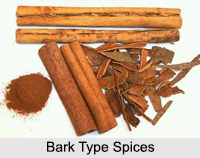 Bark Type Spices constitute the bark of a plant which is used as a culinary ingredient. These bark type spices are highly flavoured and impart taste to the food, it is mixed with. The two very common Bark type spices are Cinnamon and Cassia.
Bark Type Spices constitute the bark of a plant which is used as a culinary ingredient. These bark type spices are highly flavoured and impart taste to the food, it is mixed with. The two very common Bark type spices are Cinnamon and Cassia.
Cinnamon
Cinnamon or "Darchini" is a very popular spice and commonly used in the Indian dietary. It is one of the oldest spices known to mankind. It is one of the highly prized spices that have been in use for its fragrance, medicinal and culinary properties. This spice is traditionally obtained from the inner brown bark of "Cinnamomum" trees. Pure cinnamon is free from any admixture with cassia, which is considered inferior to the former in appearance, flavour and odour.
Cassia
Cassia is one of the important and a distinguished Bark type spices in India. Cassia, also called "Chinese Cinnamon", spice consisting of the aromatic bark of the "Cinnamomum cassia" plant of the family "Lauraceae". Similar to true cinnamon, cassia bark has a more pungent, less delicate flavour and is thicker than cinnamon bark. Its bark is darker, thicker and coarser, and the corky outer bark is often left on. The outer surface is rough and greyish brown; the inside of the bark is smoother and reddish-brown. It is less costly than cinnamon.
Collecting of Bark Type Spices
Barking, that is removal of bark, is usually carried on the standing tree, starting with the main branches and working down the trunk, not by climbing but by erecting bamboo scaffolding around it. A string is tied round the trunk and main branches at intervals of 40 cm and the bark is cut through at these points with a sharp pointed knife. Then vertical cuts are made between the horizontal incisions at intervals of 25 to 35 cm and the slabs of barks are eased off with the aid of thin spatulas made of bamboo or buffalo horn. Each ring of bark is removed in this way until the bottom of the trunk is reached; the tree is then felled after which small branches and twigs are harvested.
Cassia (Jangli Dalchini) and Cinnamon (Dalchini or Darchini) are very popular Bark type spices whish are commonly used in the Indian Culinary. Bark type spices are quite popular in Indian kitchens for their flavouring qualities.




















